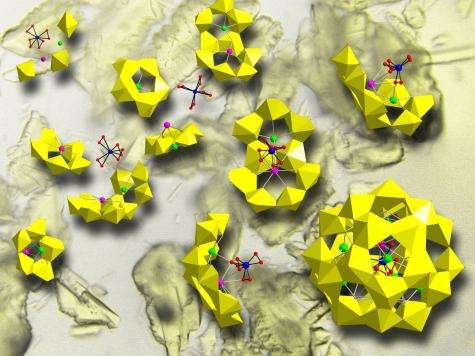Recipe for radioactive compounds aids nuclear waste and fuel storage pools studies

(PhysOrg.com) -- Easy-to-follow recipes for radioactive compounds like those found in nuclear fuel storage pools, liquid waste containment areas and other contaminated aqueous environments have been developed by researchers at Sandia National Laboratories.
“The need to understand the chemistry of these compounds has never been more urgent, and these recipes facilitate their study,” principal investigator May Nyman said of her group’s success in encouraging significant amounts of relevant compounds to self-assemble.
The trick to the recipes is choosing the right templates. These are atoms or molecules that direct the growth of compounds in much the way islands act as templates for coral reefs.
The synthesized materials are stable, pure and can be studied in solution or as solids, making it easier to investigate their chemistry, transport properties and related phases.
The compounds are bright yellow, soluble peroxides of uranium called uranyl peroxide. These and related compounds may be present in any liquid medium used in the nuclear fuel cycle. They also appear in the environment from natural or human causes.
Made with relatively inexpensive and safe depleted uranium, the recipes may be adapted to include other, more radioactive metals such as neptunium, whose effects are even more important to study, Nyman said.
Cesium — an element of particular concern in its radioactive form — proved to be, chemically, an especially favored template for the compounds to self-assemble.
More information: The research will be featured as the cover article of the May 3 online European Journal of Inorganic Chemistry, to be published in print May 13. dx.doi.org/10.1002/ejic.201001355
Provided by Sandia National Laboratories

















